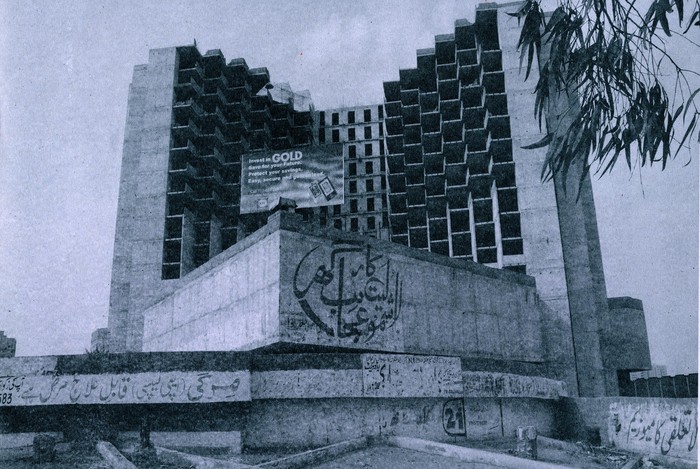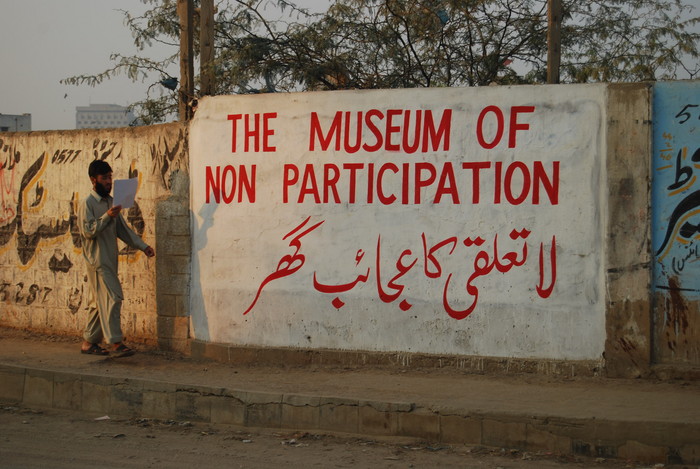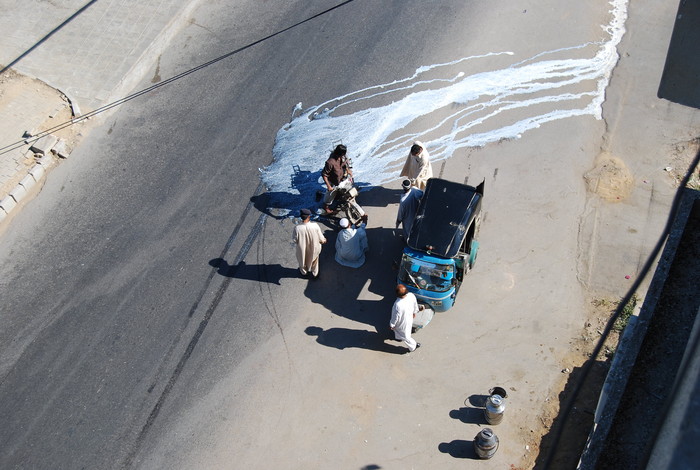#15 "IMAGES I WISH I HAD FILMED BUT COULDN’T" A SCREENING FOR PRODUCTION. WITH KAREN MIRZA AND BRAD BUTLER (LONDON)

Museum of Non Participation flyer for the Shanaakht Festival, Karachi (c) Butler / Mirza


The fifteenth issue of SCREENING IN GENERAL is a screening for live-production with a set of components of The Museum of Non Participation founded by Karen Mirza and Brad Butler. Part of the Museum is their film project The Exception and the Rule.
GENERAL PUBLIC After the entrance sequence, your film The Exception and The Rule continues with a voice-off referring to Raj Kumar. He is called a video-activist later on and collaborates with you in this project. Can you tell me why you felt this collaboration was required?
KAREN MIRZA Raj Kumar is a fictional character, he also stands in for all the possible collaborators and voices within the fabric of the film, it/he is exchangable as a part of the economy of collaboration. He is the people we stayed with, the friends who would help us, the invitations to places we would not have known of otherwise...
BRAD BUTLER Raj is also a voice of critique from inside the film looking out, to contrast the viewer's position from the outside looking in. This film argues that knowledge is relational and so it uses a structure that puts emphasis on how knowledge 'appears' meaningful. This fictional collaborative partner offers access to a different perspective on the film and within the film. This character is called Raj Kumar because Raj was the main character in the language books we were using to learn Hindi. But Raj also represents a way of incorporating an analysis of control, authorship and identity. Raj confuses the relationship between where ideas and images for the film come from. Early on we also resolved to ambiguously link the images that Raj would claim as ‘his’ with Digital Video as a recording mechanism. “So that broadly speaking wherever the audience recognises that something has being originated on Video then it was probably filmed by Raj”. Framing authorship in this way also makes the influence of Raj a perceptual issue personal to each viewer as the relationship between film and video in this work is also ambiguous.
GENERAL PUBLIC The film is mainly located in Karachi which is a seaport city in Pakistan on the coast of the Indian Ocean. It is highly populated place not close to the Indian border at all. However, in a sequence called Intermission we see a soldiers ceremony at the border between Pakistan and India. These kind of images have become iconic numbers representing the conflict between India and Pakistan. What were the reasons to shoot and show the border scenes with regard to Karachi?
KAREN MIRZA The film is presented in two halves and the Intermission you are referring to we think of as the "liminal space" between the two acts. The first half of the film is constructed much more for 'the head' as it is more analytical, and the second half targets the body as it is sensoral and gutteral with its instinct to produce language rather than be produced by language. The Intermission is the threshold that physically and symbolically reminds the viewer of the psychological and historical partition between India and Pakistan, the splitting of the self. These ideas underscore our approach to the pro-filmic, filming and editing construction in the film. The filming of the ceremony at the Wagah Border seemed to fit this.
BRAD BUTLER This is also played out in film language so that it is the mise-en-scène that constitutes the first half of the film while montage constitutes the second. The mise-en-scène is designed to provoke representational questions, while the montage and soundscape post Intermission is designed to create a physical and sensorial feeling that directly implicate the limitations of vision. In this second half the repeated sentence 'Images I wish I had filmed but couldn’t' talks about the images that escaped capture but which are the fabric of living in the everyday: "The woman at the bus stop who realised she had forgotten something, Sitting in the car with Sohail and smoking Marlboro’s, Watching Dostana at the local Cineplex, The morning of the Mumbai attacks" This is Exphrastic Ethnography or the use of one art medium to define and describe another. Though in this case this is structured to pose possibilities – that the roads not taken as significant as those that are.
GENERAL PUBLIC There is quite a long quote from an interview with Jean-Luc Godard in the film where he talks about 'the right to work' with regard to film making. What is your relation to references, i.e. which urgency do they occupy in your work and how do you actualize them?
BRAD BUTLER/KAREN MIRZA There are many western art and film references in The Exception and the Rule though only a few are literally pointed out. This is because in this film we considered even the references we carry with us un/consciously to be sites of negotiation. This is an approach to filmmaking that recognises that complex multiple layers of control, authority and manipulation are embedded in all aspects of any film post/production including its projection, the camera apparatus and the cultural bias of the filmmakers. That said we do not consider 'cultural bias' easy to define. It is after all one of the most important realities of late modernity and modernism that we all share conditions of modernity with each other. That in our local global world there is a great deal of complexity of cultural movements that cross physical and mental borders in a a complex multilayered process of repetition and feedback. This is in the end how the film works also, using different immersion levels to both pull the viewer in and to hold them out. This play with (film) language reflects the barriers faced in life, the sense that there are situations we can access and also many more that we cannot.
GENERAL PUBLIC Can you say a few words about the use of the title which quotes a Lehrstück by Bert Brecht?
BRAD BUTLER/KAREN MIRZA The title is there to open up meaning rather than close it down. One of the most exciting thing we enjoy about language is finding its limits. This is an idea we explore in many ways in "The Museum of non Particpation" of which this film is a part. But it is even evident in the title of the film itself. For example what does this title really mean? Because if The Rule gives rise to the Exception and maintains itself in relation to the Exception, as a Rule, then isn't the Rule equally unlocalizable? As Auge says "we all have the feeling that we are being colonised but we don’t exactly know who by; the enemy is not easily identifiable; and one can venture to suggest that this feeling now exists all over the world". Perhaps Brecht would support this idea also...?
www.mirza-butler.net www.no-w-here.org.uk
London/Berlin, January 2010
# 15 "Images I wish I had filmed but couldn’t"
A screening for production.
With Karen Mirza and Brad Butler (London)
Date: Wednesday, February 10, 2010
Location: General Public, Berlin
Time: 8PM
Duration: ca. 90 Min
General Public
Schönhauser Allee 167c
DE 10435 Berlin
www.generalpublic.de
Invited by the Members of General Public.
